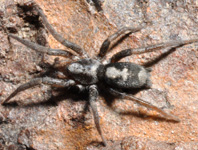Abstract
The American gnaphosid genus Apopyllus Platnick & Shadab is found from southern Mexico to southern Argentina. It can be diagnosed by the complex shape of the RTA, by the membranous tegular extension, the long coiled embolus, the retrolateral incision on the cymbium, the long convoluted copulatory duct extending anteriorly to the copulatory openings and by the presence of paramedian epigynal pockets and of an anterior ridge on the epigynum. The RTA characters are important in species taxonomy but the complex shape and variation of the RTA hampers identification, especially regarding the two most common species: A. suavis (Simon) and A. silvestrii (Simon). In this paper the genus is revised, the genital morphology is described, and homology between its components and those of other genera is discussed. Apopyllus suavis is considered a senior synonym of Apopyllus pauper (Mello-Leitão) and A. iheringi (Mello-Leitão). Four new species are described from Brazil: A. aeolicus, A. atlanticus, A. centralis and A. gandarela.
References
Álvarez-Padilla, F. & Hormiga, G. (2007) A protocol for digesting internal soft tissues and mounting spiders for scanning electron microscopy. Journal of Arachnology, 35, 538–542.
http://dx.doi.org/10.1636/Sh06-55.1Brescovit, A.D. & Lise, A.A. (1993) Novas espécies e ocorrências de aranhas dos gêneros Apodrassodes e Apopylus (Araneae, Gnaphosidae). Biociências, 1, 101–110.
Brown, B.V. (2013) Automating the “Material examined” section of taxonomic papers to speed up species descriptions. Zootaxa, 3683 (3), 297–299.
http://dx.doi.org/10.11646/zootaxa.3683.3.8Crews, S.C. (2009) Assessment of rampant genitalic variation in the spider genus Homalonychus (Araneae, Homalonychidae). Invertebrate Biology, 128, 107–125.
http://dx.doi.org/10.1111/j.1744-7410.2008.00157.xEberhard, W.G. (2010) Evolution of genitalia: theories, evidence, and new directions. Genetica, 138, 5–18.
http://dx.doi.org/10.1007/s10709-009-9358-yEberhard, W.G. & Huber, B.A. (2010) Spider genitalia: precise maneuvers with a numb structure in a complex lock. In: Leonard, J.L. & Córdoba-Aguilar, A. (Eds.), Evolution of primary sexual characters in animals. Oxford University Press, Oxford, pp. 249–284.
Garrison, N., Rodriguez, J., Agnarsson, I., Coddington, J., Griswold, C., Hamilton, C., Hedin, M., Kocot, K., Ledford, J. & Bond, J. (2016) Spider Phylogenomics: Untangling the Spider Tree of Life. PeerJ, 4, e1719.
http://dx.doi.org/10.7717/peerj.1719Hepner, M. & Milasowszky, N. (2006) Morphological separation of the Central European Trochosa females (Araneae, Lycosidae). Arachnologische Mitteilungen, 31, 1–7.
http://dx.doi.org/10.5431/aramit3101Holm, Å. (1979) A taxonomic study of European and East African species of the genera Pelecopsis and Trichopterna (Araneae Linyphiidae) with descriptions of a new genus and two new species of Pelecopsis from Kenya. Zoologica Scripta, 8, 255–278.
http://dx.doi.org/10.1111/j.1463-6409.1979.tb00638.xHuber, B.A. (1995) The retrolateral tibial apophysis in spiders - shaped by sexual selection? Zoological Journal of the Linnean Society, 113, 151–163.
http://dx.doi.org/10.1111/j.1096-3642.1995.tb00931.xLevi, H.W. (1965) Techniques for the study of spider genitalia. Psyche, 72, 152–158.
http://dx.doi.org/10.1155/1965/94978Mello-Leitão, C.F. (1941) Las Arañas de Córdoba, La Rioja, Catamarca, Tucuman, Salta y Jujuy. Revista del Museo de la Plata (Nueva Serie), Serie Zoología, 2, 99–198.
Mello-Leitão, C.F. (1942) Arañas del Chaco y Santiago del Estero. Revista del Museo de la Plata (Nueva Serie), Serie Zoología, 2, 381–426.
Mello-Leitão, C.F. (1943) Araneologica varia brasiliana. Anais da Academia Brasileira de Ciências, 15, 255–265.
Mello-Leitão, C.F. (1944) Arañas de la provincia de Buenos Aires. Revista del Museo de la Plata (Nueva Seria), Sección Zoología, 3, 311–393.
Milasowszky, N., Herberstein, M.E., Zulka, K.P. & Selden, P. (1998) Morphological separation of Trochosa robusta (Simon, 1876) and Trochosa ruricola (De Geer, 1778) females (Araneae: Lycosidae). In: Seldon, P.A. (Ed.), Proceedings of the 17th European Colloquium of Arachnology. Edinburgh 1997. British Arachnological Society, Burnham Beeches, Bucks, pp. 91–96.
Murphy, J.A. (2007) Gnaphosid Genera of the World. British Arachnological Society.
Ott, R. (2014) Nopyllus, um novo gênero de Drassodinae sul-americano (Araneae, Gnaphosidae). Iheringia. Série Zoologia, 104, 252–261.
http://dx.doi.org/10.1590/1678-476620141042252261Ovtsharenko, V., Levy, G. & Platnick, N. (1994) A review of the ground spider genus Synaphosus (Araneae, Gnaphosidae). American Museum Novitates, 27, 1–27.
Petrunkevitch, A. (1911) A synonymic index-catalogue of spiders of north, central and south America with all adjacent islands, Greenland, Bermuda, West Indies, Tierra del Fuego, Galapagos, etc. Bulletin of the American Museum of Natural History, 29, 1–791
Platnick, N.I. (1983) A revision of the neotropical spider genus Apodrassodes (Araneae, Gnaphosidae). American Museum Novitates, 2763, 1–14.
Platnick, N.I. & Shadab, M.U. (1975) A revision of the spider genus Gnaphosa (Araneae, Gnaphosidae) in America. Bulletin of the American Museum of Natural History, 155, 1–66.
Platnick, N.I. & Shadab, M.U. (1984) A revision of the neotropical spiders of the genus Apopyllus (Araneae, Gnaphosidae). American Museum Novitates, 2788, 1–9.
Polotow, D., Carmichael, A. & Griswold, C. (2015) Total evidence analysis of the phylogenetic relationships of Lycosoidea spiders (Araneae, Entelegynae). Invertebrate Systematics, 29, 124–163.
http://dx.doi.org/10.1071/IS14041Ramírez, M.J. (2014) The morphology and phylogeny of dionychan spiders (Araneae: Araneomorphae). Bulletin of the American Museum of Natural History, 390, 1–374.
http://dx.doi.org/10.1206/821.1Salgado, A.A.R. & do Carmo, F.F. (2015) ‘Quadrilátero Ferrífero’: A Beautiful and Neglected Landscape Between the Gold and Iron Ore Reservoirs. In: Landscapes and Landforms of Brazil. Springer, Dordrecht, pp. 319–330.
http://dx.doi.org/10.1007/978-94-017-8023-0_29Senglet, A. (2004) Copulatory mechanisms in Zelotes, Drasillus and Trachyzelotes (Araneae, Gnaphosidae) with additional faunistic and taxonomy data on species from Southwest Europe. Mitteilungen der Schweizerischen Entomologischen Gesellschaft, 77, 87–119.
Sierwald, P. (1989) Morphology and ontogeny of female copulatory organs in American Pisauridae, with special reference to homologous features (Arachnida, Araneae). Smithsonian Contributions to Zoology, 484, 1–24.
http://dx.doi.org/10.5479/si.00810282.484Simon, E. (1893) Arachnides. In: Voyage de M. E. Simon au Venezuela (décembre 1887 - avril 1888). 21e Mémoire. Annales de la Société Entomologique de France, 61, 423–462.
Simon, E. (1905) Etude sur les Arachnides recueillis en Patagonie par le Dr Filippo Silvestri. Bollettino dei musei di zoologia ed anatomia comparata della R. Università di Torino, 20, 1–17.
Vellard, J. (1924) Etudes de zoologie. Archivos do Instituto Vital Brazil, 2, 121–170.
Zakharov, B.P. & Ovtcharenko, V.I. (2011) Morphological organization of the male palpal organ in Australian ground spiders of the genera Anzacia, Intruda, Zelanda, and Encoptarthria (Araneae: Gnaphosidae). Journal of Arachnology, 39, 327–336.
http://dx.doi.org/10.1636/CA10-91.1

